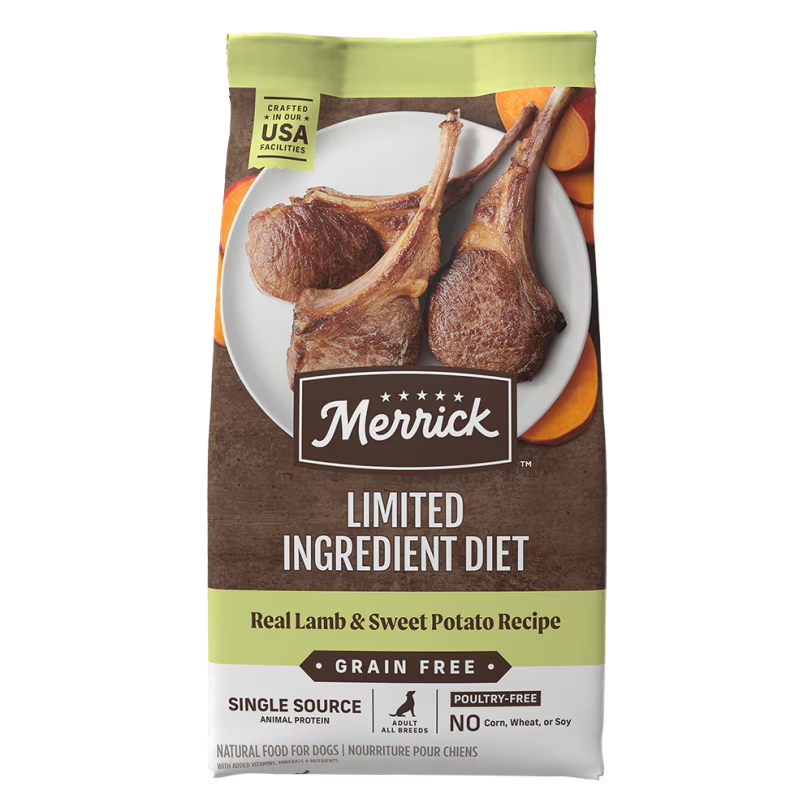
DogFoodAdvisor is reader supported See how
All reviews are 100% impartial but if you buy using links on this page, we may earn a referral fee.
Our Verdict
Merrick Limited Ingredient dry product range is made up of four recipes which each receive the Dog Food Advisor’s rating, 3.5 stars.
The table below shows each recipe in this range including our rating and the AAFCO nutrient profile: Growth (puppy), Maintenance (adult), All Life Stages, Supplemental or Unspecified.
| Product line | Rating | AAFCO |
|---|---|---|
| Merrick Limited Ingredient Diet Real Salmon and Brown Rice Recipe | 3.5 | M |
| Merrick Limited Ingredient Diet Real Lamb and Sweet Potato Recipe | 3.5 | M |
| Merrick Limited Ingredient Diet Real Chicken and Brown Rice Recipe | 3.5 | M |
| Merrick Limited Ingredient Real Salmon and Sweet Potato Recipe | 3.5 | M |
Recipe and Label Analysis
Merrick Limited Ingredient Real Lamb and Sweet Potato Recipe was selected to represent the other products in the line for detailed recipe and nutrient analysis.
Merrick Limited Ingredient Diet Real Lamb and Sweet Potato Recipe
Estimated Dry Matter Nutrient Content
Protein
Fat
CarbsCarbohydrates
Deboned lamb, lamb meal, sweet potatoes, potatoes, peas, canola oil, potato protein, pea protein, flaxseed, natural flavor, miscanthus grass, dried yeast, potassium chloride, salt, choline chloride, minerals [zinc amino acid complex, iron amino acid complex, sodium selenite, manganese amino acid complex, copper amino acid complex, calcium iodate], dl-methionine, sunflower oil, taurine, vitamins [vitamin E supplement, vitamin B-12 supplement, vitamin A supplement, niacin (vitamin B-3), thiamine mononitrate (vitamin B-1), calcium pantothenate (vitamin B-5), folic acid (vitamin B-9), riboflavin supplement (vitamin B-2), menadione sodium bisulfite complex (vitamin k), pyridoxine hydrochloride (vitamin B-6), biotin (vitamin B-7), vitamin D-3 supplement], mixed tocopherols for freshness
Fiber (estimated dry matter content) = 4.5%
Red denotes any controversial items
| Estimated Nutrient Content | |||
|---|---|---|---|
| Method | Protein | Fat | Carbs |
| Guaranteed Analysis | 23% | 14% | NA |
| Dry Matter Basis | 26% | 16% | 51% |
| Calorie Weighted Basis | 23% | 33% | 44% |
Ingredients Analysis
The first ingredient in this dog food is lamb. Although it is a quality item, raw lamb contains up to 73% water. After cooking, most of that moisture is lost, reducing the meat content to just a fraction of its original weight.
After processing, this item would probably account for a smaller part of the total content of the finished product.
The second ingredient is lamb meal. Lamb meal is considered a meat concentrate and contains nearly 300% more protein than fresh lamb.
The third ingredient is sweet potato. Sweet potatoes are a gluten-free source of complex carbohydrates in dog food. They are naturally rich in dietary fiber and beta carotene.
The next ingredient is potato, another source of digestible carbohydrates. Yet with the exception of perhaps their caloric content, potatoes are of only modest nutritional value to a dog.
The fifth ingredient includes peas. Peas are a quality source of carbohydrates. And like all legumes, they’re rich in natural fiber.
However, peas contain about 25% protein, a factor that must be considered when judging the meat content of this dog food.
The sixth item is canola oil. Unfortunately, canola can be a controversial item. That’s because it can sometimes (but not always) be derived from genetically modified rapeseed.
Yet others cite the fact that canola oil can be a significant source of essential omega-3 fatty acids.
In any case, plant-based oils like canola are less biologically available to a dog than fish oil as a source of quality omega-3 fats.
The seventh ingredient is potato protein, the dry residue remaining after removing the starchy part of a potato.
The eighth ingredient is pea protein, what remains of a pea after removing the starchy part of the vegetable.
Even though these last two ingredients contain over 80% protein, they would be expected to have a lower biological value than meat.
And both of these less costly plant-based products can notably boost the total protein reported on the label — a factor that must be considered when judging the meat content of this dog food.
The ninth ingredient is flaxseed, one of the best plant sources of healthy omega-3 fatty acids. Provided they’ve first been ground into a meal, flax seeds are also rich in soluble fiber.
However, flaxseed contains about 19% protein, a factor that must be considered when judging the actual meat content of this dog food.
From here, the list goes on to include a number of other items.
But to be realistic, ingredients located this far down the list (other than nutritional supplements) are not likely to affect the overall rating of this Merrick product.
With five notable exceptions…
First, we find chelated minerals, minerals that have been chemically attached to protein. This makes them easier to absorb. Chelated minerals are usually found in better dog foods.
Next, this product contains sodium selenite, a controversial form of the mineral selenium. Sodium selenite appears to be nutritionally inferior to the more natural source of selenium found in selenium yeast.
In addition, we note the use of taurine, an important amino acid associated with the healthy function of heart muscle. Although taurine is not typically considered essential in canines, some dogs have been shown to be deficient in this critical nutrient.
Since taurine deficiency appears to be more common in pets consuming grain-free diets, we view its presence in this recipe as a positive addition.
Next, we find no mention of probiotics, friendly bacteria applied to the surface of the kibble after processing to help with digestion.
And lastly, this recipe includes menadione, a controversial form of vitamin K linked to liver toxicity, allergies and the abnormal break-down of red blood cells.
Since vitamin K isn’t required by AAFCO in its nutrient profiles, we question the use of this item in any canine recipe.
Nutrient Analysis
Based on its ingredients alone, Merrick Limited Ingredient Real Lamb and Sweet Potato Recipe looks like an average dry product.
The dashboard displays a dry matter protein reading of 26%, a fat level of 16% and estimated carbohydrates of about 50%.
As a group, the brand features an average protein content of 25% and a mean fat level of 16%. Together, these figures suggest a carbohydrate content of 51% for the overall product line.
And a fat-to-protein ratio of about 63%.
Which means this Merrick product line contains…
Near-average protein. Near-average fat. And above-average carbs when compared to other kibbles.
When you consider the protein-boosting effect of the peas, potato protein, pea protein and flaxseed, this looks like the profile of a kibble containing just a moderate amount of meat.
Merrick Dog Food Recall History
The following automated list (if present) includes all dog food recalls related to Merrick through April 2025.
- Merrick Recalls Multiple Dog Treats (May 23, 2018)
- Merrick Recalls Dog Treats (August 9, 2011)
- Merrick Pet Treats Recall 2011 (January 30, 2011)
- Merrick Expands Dog Treats Recall (August 16, 2010)
- Merrick Expands Recall of Dog Treats (August 4, 2010)
- Merrick Dog Treats Recall (July 6, 2010)
- Merrick Dog Treats Recall 2010 (January 15, 2010)
You can view a complete list of all dog food recalls since 2009 here.
Our Rating of Merrick Limited Ingredient Dog Food
Merrick Limited Ingredient Diet offers both grain-inclusive and grain-free dry dog foods that use a moderate amount of named meat meals as their dominant source of animal protein, thus receiving 3.5 stars.
However, it’s unfortunate the company chose to include menadione in its recipes. Without this controversial supplement and minus the plant-based protein boosters, we would have been compelled to award this brand a higher rating.
Compare Merrick Limited Ingredient Dog Food
How does Merrick Limited Ingredient compare with The Dog Food Advisor's most recommended brands?
A Final Word
The Dog Food Advisor does not accept money, gifts, samples or other incentives in exchange for special consideration in preparing our reviews.
However, we do receive a referral fee from online retailers (like Chewy or Amazon) and from sellers of perishable pet food when readers click over to their websites from ours. This helps cover the cost of operation of our free blog. Thanks for your support.
For more information, please visit our Disclaimer and Disclosure page.









